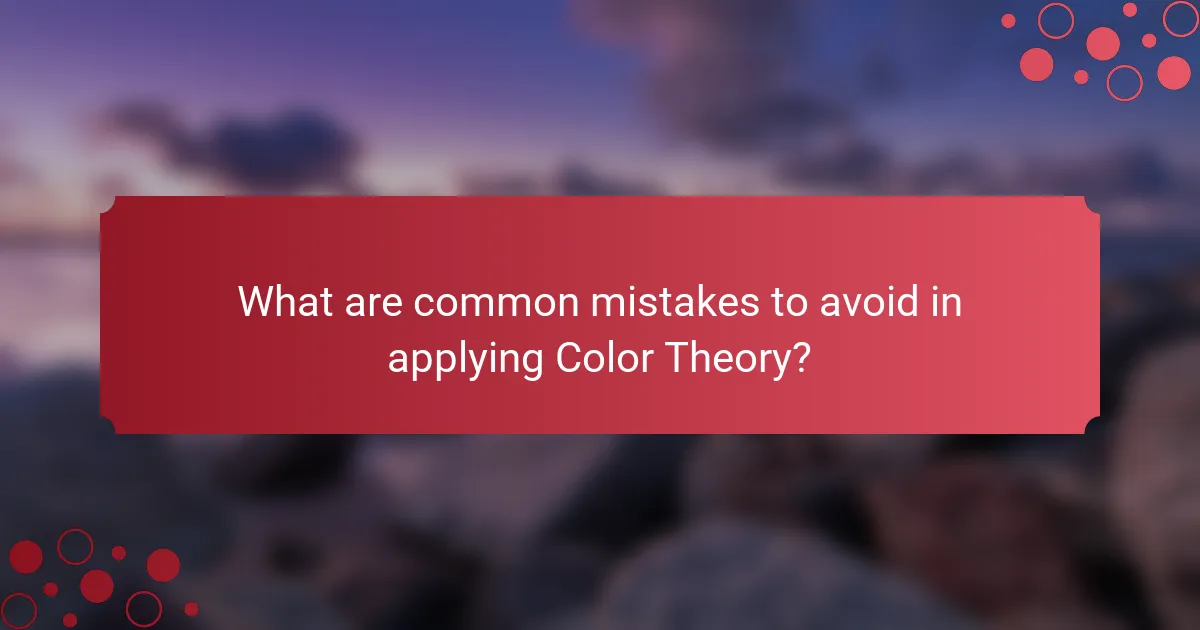Color theory in web design is the examination of how colors interact with each other and impact user experience. This article explores the principles of color combinations, contrasts, and the psychological effects of colors on users, emphasizing the importance of effective color schemes for enhancing aesthetic appeal and usability. Key concepts include the use of complementary and analogous colors to create visual balance and harmony, respectively. The article also highlights the significant influence of color on user emotions, behavior, and decision-making, supported by research findings on color’s effect on conversion rates. Additionally, it addresses common pitfalls in applying color theory, such as overusing colors and neglecting accessibility, while stressing the necessity of testing color combinations for optimal design outcomes.

What is Color Theory in Web Design?
Color theory in web design is the study of how colors interact and influence user experience. It involves understanding color combinations, contrasts, and the psychological effects of colors on users. Effective color schemes enhance aesthetic appeal and usability. For instance, complementary colors create visual balance, while analogous colors provide harmony. Research shows that color can affect emotions and behavior, impacting decisions and engagement. According to a study by the Institute for Color Research, people make a subconscious judgment about a product within 90 seconds of seeing it, and 62-90% of that assessment is based on color alone. Thus, applying color theory is crucial for effective web design.
How does Color Theory influence web design choices?
Color theory significantly influences web design choices by guiding color selection for visual appeal and user experience. Designers use color schemes to create harmony and contrast in layouts. For example, complementary colors enhance readability. Analogous colors provide a cohesive look, while triadic schemes offer vibrant contrasts. Additionally, colors evoke emotions; blue conveys trust, while red signifies urgency. Research indicates that 90% of snap judgments about products are based on color alone. Therefore, understanding color theory helps designers make informed decisions that enhance aesthetics and usability.
What are the basic principles of Color Theory?
The basic principles of Color Theory include the color wheel, primary colors, secondary colors, and tertiary colors. The color wheel organizes colors into a circular format. Primary colors are red, blue, and yellow. These colors cannot be created by mixing others. Secondary colors result from mixing primary colors. They include green, orange, and purple. Tertiary colors arise from mixing primary and secondary colors. Examples include red-orange and yellow-green. Color harmony is another principle. It involves creating pleasing color combinations. Color contrast enhances visual interest and readability. These principles guide effective color use in design.
How do color combinations impact user experience?
Color combinations significantly impact user experience by influencing perception and emotional response. Effective color schemes enhance usability and guide user interactions. For example, contrasting colors improve readability and focus attention on key elements. Research shows that color affects user behavior; 85% of consumers make purchasing decisions based on color. Warm colors can evoke excitement, while cool colors promote calmness. Additionally, consistent color usage builds brand recognition. Poor color choices can lead to confusion and frustration, negatively affecting user satisfaction. Therefore, thoughtful color combinations are essential for creating a positive user experience.
What are the primary color schemes used in web design?
The primary color schemes used in web design include monochromatic, analogous, complementary, triadic, and tetradic schemes. Monochromatic schemes use variations of a single hue. This creates a harmonious and cohesive look. Analogous schemes involve colors that are next to each other on the color wheel. They provide a serene and comfortable palette. Complementary schemes use colors that are opposite each other on the color wheel. This creates high contrast and vibrant visuals. Triadic schemes consist of three colors evenly spaced around the color wheel. They offer a balanced yet dynamic appearance. Tetradic schemes use two complementary pairs. This provides a rich and diverse color palette. These schemes are fundamental in creating effective web designs.
What is the difference between complementary and analogous color schemes?
Complementary color schemes consist of colors located opposite each other on the color wheel. This creates high contrast and vibrant visuals. For example, blue and orange are complementary colors. Analogous color schemes involve colors that are next to each other on the color wheel. This results in a harmonious and cohesive look. For instance, blue, blue-green, and green form an analogous scheme. The key difference lies in the contrast level. Complementary schemes provide dynamic tension, while analogous schemes offer a more serene and unified appearance.
How do triadic and tetradic color schemes function?
Triadic and tetradic color schemes function by utilizing specific color relationships on the color wheel. A triadic color scheme consists of three colors that are evenly spaced around the color wheel. This creates a vibrant and balanced palette. In contrast, a tetradic color scheme involves four colors, forming a rectangle on the color wheel. This scheme includes two complementary color pairs. Both schemes offer visual interest and variety. Triadic schemes are often used for dynamic designs, while tetradic schemes provide more complexity and richness. These functions are widely recognized in color theory, supporting effective design choices in various applications.
Why is understanding color psychology important for web designers?
Understanding color psychology is crucial for web designers because it influences user behavior and perception. Colors evoke emotions and can affect decision-making. For instance, blue is often associated with trust, while red can create a sense of urgency. Research shows that 85% of consumers make purchase decisions based on color. A well-chosen color scheme can enhance user experience and improve engagement. Effective use of color can lead to higher conversion rates. Therefore, web designers must grasp color psychology to create impactful designs that resonate with their audience.
What emotions do different colors evoke in users?
Different colors evoke specific emotions in users. Red typically evokes feelings of passion and urgency. Blue is associated with calmness and trust. Yellow often inspires happiness and optimism. Green is linked to nature and tranquility. Orange can evoke enthusiasm and warmth. Purple is often connected to luxury and creativity. Black tends to signify elegance and sophistication. White is associated with purity and simplicity. These associations are supported by psychological studies, such as those conducted by the Institute for Color Research, which demonstrate that colors can influence mood and behavior.
How can color choices align with brand identity?
Color choices can align with brand identity by evoking specific emotions and perceptions. Colors can communicate brand values and personality effectively. For instance, blue often represents trust and professionalism. Brands like IBM and Facebook utilize blue to reinforce these traits. Red can signify passion and excitement, as seen in brands like Coca-Cola and Target. Research shows that color increases brand recognition by up to 80%. This indicates that consistent color use strengthens brand identity. Thus, selecting colors that reflect the brand’s core message is crucial for effective branding.

How can Color Theory be applied in web design?
Color theory can be applied in web design to create visually appealing and effective user interfaces. It involves using color schemes that evoke specific emotions and guide user behavior. Designers often use complementary colors to create contrast and draw attention to important elements. Analogous colors can create harmony and a cohesive look across a website.
The psychology of color plays a crucial role in influencing user perception and engagement. For example, blue often conveys trust and professionalism, making it suitable for corporate websites. Red can evoke urgency, which is effective for call-to-action buttons.
Research shows that color affects conversion rates; a study by HubSpot found that colored buttons can increase click-through rates by 21%. Understanding color theory helps designers select appropriate palettes that enhance usability and aesthetics.
What are the best practices for using color in web design?
The best practices for using color in web design include ensuring high contrast for readability. High contrast between text and background improves legibility. Use a limited color palette to create a cohesive look. A palette of three to five colors is often effective. Consider color psychology to evoke specific emotions. For example, blue can convey trust while red can evoke urgency. Maintain accessibility by adhering to WCAG guidelines for color contrast. Test color combinations for usability across different devices and lighting conditions. Finally, ensure consistency in color usage throughout the site for branding purposes.
How should color be used to enhance readability?
Color should be used to enhance readability by ensuring sufficient contrast between text and background. High contrast improves visibility and makes text easier to read. For example, black text on a white background is highly legible. Using complementary colors can also create a visually appealing yet readable design. Studies show that color combinations like dark blue on light yellow improve reading speed. Furthermore, color should be used consistently to avoid confusion. Consistent color schemes help users quickly identify important information. Overall, strategic color choices significantly impact readability and user experience.
What role does contrast play in effective web design?
Contrast is essential in effective web design as it enhances readability and visual hierarchy. It helps differentiate between various elements on a webpage. High contrast between text and background improves legibility, making it easier for users to read content. For instance, black text on a white background is a classic example of effective contrast. Additionally, contrast guides users’ attention to important information, such as calls to action. Studies show that well-implemented contrast can increase user engagement and retention. Therefore, using contrast effectively can significantly impact the overall user experience on a website.
How can accessibility be ensured through color choices?
Accessibility can be ensured through color choices by using high contrast ratios. High contrast improves readability for individuals with visual impairments. The Web Content Accessibility Guidelines (WCAG) recommend a contrast ratio of at least 4.5:1 for normal text. Designers should avoid color combinations that can cause confusion, such as red and green. Additionally, using color not solely as a means of conveying information is important. Text labels and patterns can supplement color to enhance understanding. Tools like contrast checkers can help evaluate color combinations for accessibility compliance. Ensuring that colors are distinguishable in various lighting conditions also supports accessibility.
What tools are available to check color contrast ratios?
Tools available to check color contrast ratios include WebAIM’s Color Contrast Checker, Contrast Ratio by Lea Verou, and the Accessible Colors tool. WebAIM’s Color Contrast Checker allows users to input foreground and background colors to assess compliance with WCAG guidelines. Contrast Ratio by Lea Verou provides a simple interface for quick checks. Accessible Colors offers a visual representation of color combinations and their contrast ratios. These tools help ensure that web content meets accessibility standards for readability.
How can color-blind users be accommodated in web design?
To accommodate color-blind users in web design, utilize high-contrast color combinations. Ensure that information is not solely conveyed through color. Use patterns, textures, and labels alongside color to enhance clarity. Implement accessible color palettes that consider common color-blindness types, such as red-green color blindness. Tools like color contrast checkers can help verify accessibility. According to the World Health Organization, approximately 300 million people globally are affected by color blindness. This statistic underscores the importance of inclusive design practices.

What are common mistakes to avoid in applying Color Theory?
Common mistakes to avoid in applying Color Theory include using too many colors. This can lead to visual confusion and detract from the design’s message. Another mistake is neglecting color harmony. Poorly matched colors can create an unpleasant aesthetic. Failing to consider color psychology is also a frequent error. Colors evoke emotions and can influence user behavior. Ignoring accessibility is a critical mistake. Designs must be legible for all users, including those with color blindness. Lastly, not testing color combinations can result in ineffective designs. Testing ensures that the intended message is conveyed clearly.
What are the pitfalls of overusing colors in web design?
Overusing colors in web design can lead to visual clutter and confusion. This occurs when too many colors distract users from the main content. Users may find it difficult to focus on important elements. A chaotic color scheme can also harm the site’s readability. Studies show that excessive colors can increase cognitive load. This makes it harder for users to process information quickly. Consistency in color usage enhances user experience and navigation. According to color theory, a limited palette improves aesthetic appeal. Therefore, balancing color use is crucial for effective web design.
How can clashing colors detract from user engagement?
Clashing colors can detract from user engagement by creating visual discomfort. This discomfort can lead to cognitive overload for users. When colors clash, they compete for attention rather than complement each other. Studies indicate that harmonious color combinations enhance readability and focus. In contrast, jarring color contrasts can cause users to leave a site prematurely. Research by the Nielsen Norman Group shows that poor color choices can reduce user satisfaction significantly. Thus, effective color schemes are essential for maintaining user interest and engagement.
What is the impact of inconsistent color usage across a website?
Inconsistent color usage across a website negatively affects user experience and brand perception. It can lead to confusion, making navigation difficult for users. Users may struggle to understand the hierarchy of information. This inconsistency can dilute brand identity and recognition. A study by the Nielsen Norman Group found that consistent design elements improve usability. Websites with uniform color schemes are perceived as more trustworthy. Inconsistent colors can also increase cognitive load, making it harder for users to process information. Overall, maintaining a cohesive color scheme is essential for effective web design.
What practical tips can enhance color application in web design?
Use a limited color palette to create visual harmony. A palette of three to five colors ensures consistency. Utilize color contrast to enhance readability. High contrast between text and background improves accessibility. Incorporate color psychology to evoke desired emotions. Different colors can influence user behavior and perception. Test color combinations with tools like Adobe Color. These tools help visualize schemes effectively. Ensure colors are web-safe for compatibility across devices. Web-safe colors maintain consistency in appearance. Regularly gather user feedback on color choices. User insights can guide effective color application.
How can designers experiment with color palettes effectively?
Designers can experiment with color palettes effectively by using color theory principles. They should start by understanding color harmony, which includes complementary, analogous, and triadic color schemes. Utilizing tools like Adobe Color or Coolors can help in generating diverse palettes. Testing colors in different contexts, such as backgrounds and typography, is essential to see how they interact. Additionally, gathering feedback from users can provide insights into emotional responses to color choices. Research indicates that colors can influence user behavior, as shown in studies by the Institute for Color Research. These methods lead to informed and effective color palette choices.
What resources are available for finding inspiration in color design?
Color design inspiration can be found in various resources. Online platforms like Pinterest and Dribbble showcase color palettes and design projects. Color scheme generators such as Coolors and Adobe Color allow users to create and explore color combinations. Design blogs often feature articles on color trends and applications. Books on color theory provide foundational knowledge and examples. Social media groups focused on design can offer community insights and inspiration. Additionally, nature and art museums serve as timeless sources of color inspiration.
Color theory in web design is the systematic study of color interactions and their impact on user experience. This article covers essential aspects of color theory, including basic principles, the influence of color combinations on user perception, and the importance of color psychology in design choices. Key topics include various color schemes such as monochromatic, complementary, and triadic, as well as practical tips for effective color application to enhance readability and accessibility. Additionally, the article highlights common mistakes to avoid and resources for designers seeking inspiration in color design.
